Rama Shanker
Department of Statistics, Eritrea Institute of Technology, Asmara, Eritrea
Correspondence to: Rama Shanker, Department of Statistics, Eritrea Institute of Technology, Asmara, Eritrea.
| Email: |  |
Copyright © 2017 Scientific & Academic Publishing. All Rights Reserved.
This work is licensed under the Creative Commons Attribution International License (CC BY).
http://creativecommons.org/licenses/by/4.0/

Abstract
In this paper, a zero-truncated Poisson-Shanker distribution (ZTPSD) has been introduced by taking the zero-truncated version of Poisson-Shanker distribution (PSD) of Shanker (2016). The expression for the rth factorial moment of the ZTPSD has been obtained and hence the first four moments about origin and central moments have been obtained. The expressions for coefficient of variation, skewness, kurtosis and index of dispersion have been presented. Method of maximum likelihood estimation and the method of moments have been discussed for estimationg the parameter of ZTPSD. Three examples of observed data sets have been presented to test the goodness of fit of ZTPSD over zero-truncated Poisson distribution (ZTPD) and Zero truncated Poisson-Lindley distribution (ZTPLD).
Keywords:
Zero-truncation, Poisson-Shanker distribution, Moments, Parameter estimation, Goodness of fit
Cite this paper: Rama Shanker, A Zero-Truncated Poisson-Shanker Distribution and Its Applications, International Journal of Statistics and Applications, Vol. 7 No. 3, 2017, pp. 159-169. doi: 10.5923/j.statistics.20170703.01.
1. Introduction
Suppose  is the original distribution. Then the zero-truncated version of
is the original distribution. Then the zero-truncated version of  is defined as
is defined as  | (1.1) |
In probability theory, zero-truncated distribution is a certain class of discrete distribution whose support is the set of positive integers. When the data to be modeled originate from a mechanism which generates data that structurally excludes zero counts, zero-truncated distribution is the appropriate choice. The probability mass function (pmf) of Poisson-Lindley distribution (PLD) given by  | (1.2) |
has been introduced by Sankaran (1970) to model count data. It is a Poisson mixture of Lindley (1958) distribution having probability density function (pdf) | (1.3) |
Ghitany et al (2008 a) has detailed study on various properties, estimation of parameter and application of Lindley distribution. Ghitany and Al-Mutairi (2009) have discussed the estimation methods of PLD along with simulation study and application. Shanker et al (2015) has detailed discussion on the applications of exponential and Lindley distributions for modeling lifetimes data from different fields of knowledge. Shanker and Hagos (2015) have discussed the applications of Poisson-Lindley distribution in biological sciences.Using (1.1) and (1.2), Ghitany et al (2008 b) obtained zero-truncated Poisson -Lindley distribution (ZTPLD) defined by its pmf | (1.4) |
Shanker et al (2015) has done comparative study on applications of ZTPLD and zero-truncated Poisson distribution (ZTPD) on different real data sets from different fields of knowledge and showed that ZTPLD gives better fit than ZTPD in almost all data sets relating to demography, biological sciences and social sciences. The zero-truncated Poisson distribution (ZTPD) is defined by its pmf | (1.5) |
In this paper, a zero-truncated Poisson-Shanker distribution (ZTPSD) has been introduced by taking the zero-truncated version of Poisson-Shanker distribution (PSD) suggested by Shanker (2016). The first four moments about origin and the moments about mean of ZTPSD have been obtained and thus expressions for coefficient of variation, skewness, kurtosis, and index of dispersion have been given. The estimation of its parameter has been discussed using maximum likelihood estimation and method of moments. Finally, applications of ZTPSD to three observed real data sets have been given to test its goodness of fit over zero-truncated Poisson distribution (ZTPD) and Zero-truncated Poisson-Lindley distribution (ZTPLD).
2. Zero-Truncated Poisson-Shanker Distribution (ZTPSD)
The Poisson-Shanker distribution defined by its pmf | (2.1) |
has been introduced by Shanker (2016) to model count data. The distribution arises from the Poisson distribution when its parameter  follows Shanker distribution introduced by Shanker (2015) with pdf
follows Shanker distribution introduced by Shanker (2015) with pdf | (2.2) |
Shanker (2015) showed that (2.2) is a better model than both exponential and Lindley (1958) distributions for modeling lifetime data from biomedical science and engineering. Using (1.1) and (2.1), the pmf of zero-truncated Poisson-Shanker distribution (ZTPSD) can be obtained as | (2.3) |
The ZTPSD can also be obtained from the size-biased Poisson distribution (SBPD) with p.m.f. | (2.4) |
when its parameter  follows a distribution having p.d.f.
follows a distribution having p.d.f. | (2.5) |
Thus the p.m.f. of ZTPSD can be obtained as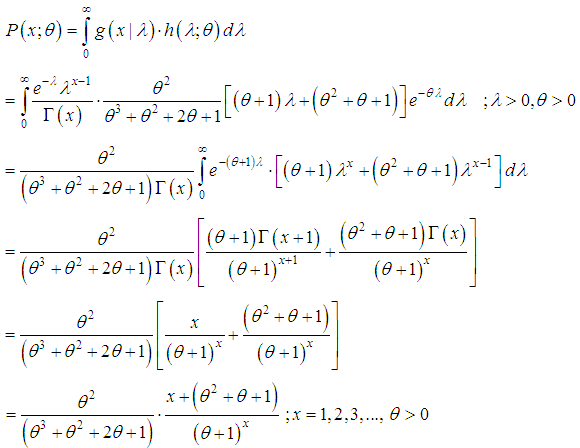 | (2.6) |
which is the p.m.f. of ZTPSD, as obtained earlier in (2.3). The main motivation of considering a continuous distribution in (2.5) is that moments of ZTPSD (2.3) can easily be obtained from the size-biased Poisson mixture of the continuous distribution using (2.6).To have a comparative study on the nature and behavior of ZTPSD and ZTPLD, several graphs of their pmf’s have been drawn for varying values of their parameter  and presented in figure 1.
and presented in figure 1.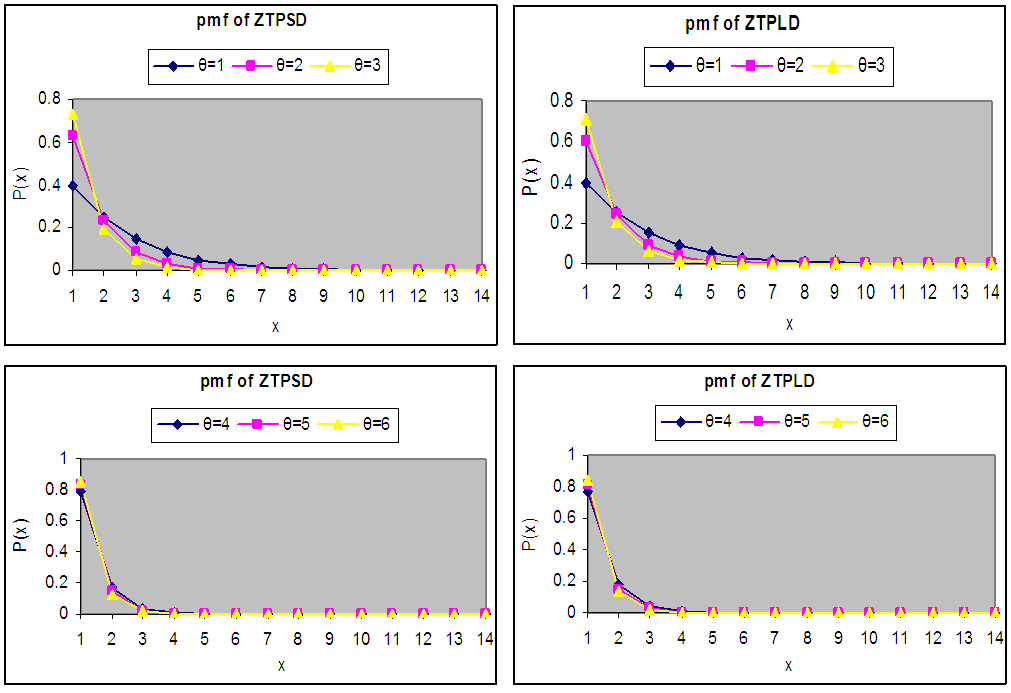 | Figure 1. Graphs of ZTPSD and ZTPLD for varying values of the parameter  |
A separate graph of ZTPSD for varying values of parameter θ has been shown in figure 2. | Figure 2. Graphs of ZTPSD for varying values of the parameter  |
Since  is a decreasing function of
is a decreasing function of  is log-concave. Therefore, ZTPSD is unimodal, has increasing failure rate (IFR), and hence increasing failure rate average (IFRA). It is new better than used (NBU), new better than used in expectation (NBUE), and has decreasing mean residual life (DMRL). Detailed discussions about the definitions of these aging concepts are available in Barlow and Proschan (1981).
is log-concave. Therefore, ZTPSD is unimodal, has increasing failure rate (IFR), and hence increasing failure rate average (IFRA). It is new better than used (NBU), new better than used in expectation (NBUE), and has decreasing mean residual life (DMRL). Detailed discussions about the definitions of these aging concepts are available in Barlow and Proschan (1981).
3. Moments and Related Measures
From (2.6), the rth factorial moment about origin of ZTPSD (2.3) can be obtained as where
where 
 Taking
Taking  in place of
in place of  we get
we get | (3.1) |
Taking r = 1,2,3 and 4 in (3.1), first four factorial moments about origin can be obtained and then using the relationship between factorial moments and moments about origin, the first four moments about origin of ZTPSD can be obtained as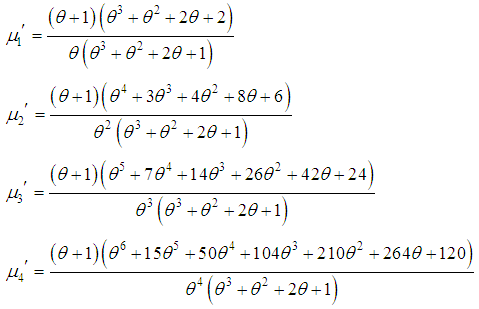 Using the relationship between moments about origin and moments about mean, the moments about mean of ZTPSD are thus obtained as
Using the relationship between moments about origin and moments about mean, the moments about mean of ZTPSD are thus obtained as The coefficient of variation (C.V), coefficient of Skewness
The coefficient of variation (C.V), coefficient of Skewness  coefficient of Kurtosis
coefficient of Kurtosis  and index of dispersion
and index of dispersion  of ZTPSD are thus obtained as
of ZTPSD are thus obtained as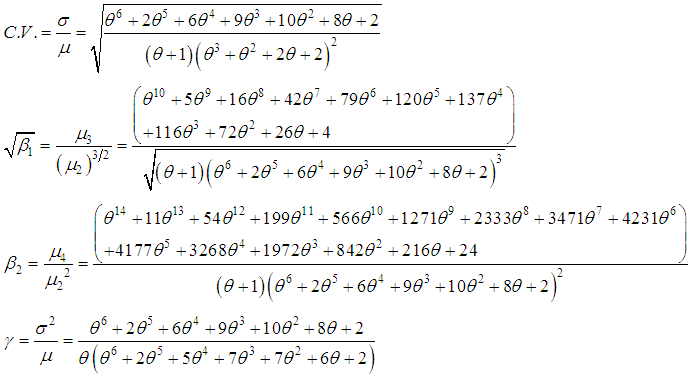 It can be easily verified that the ZTPSD is over dispersed
It can be easily verified that the ZTPSD is over dispersed  equi-dispersed
equi-dispersed  and under dispersed
and under dispersed for
for  respectively. Note that the ZTPLD is over dispersed
respectively. Note that the ZTPLD is over dispersed  , equi-dispersed
, equi-dispersed  and under dispersed
and under dispersed  for
for  respectively.The nature of coefficient of variation, coefficient of skewness, coefficient of kurtosis, and index of dispersion of ZTPSD for varying values of the parameter θ are shown in figure 3.
respectively.The nature of coefficient of variation, coefficient of skewness, coefficient of kurtosis, and index of dispersion of ZTPSD for varying values of the parameter θ are shown in figure 3. | Figure 3. Graphs of coefficient of variation, coefficient of skewness, coefficient of kurtosis, and index of dispersion of ZTPSD for varying values of the parameter θ |
To study the comparative nature of mean, variance, coefficient of variation, coefficient of skewness, coefficient of kurtosis, and index of dispersion of ZTPSD and ZTPLD for varying values of the parameter θ, a table for their values have been prepared and presented in table 1.Table 1. Numerical values of
 and and
 of ZTPSD and ZTPLD of ZTPSD and ZTPLD
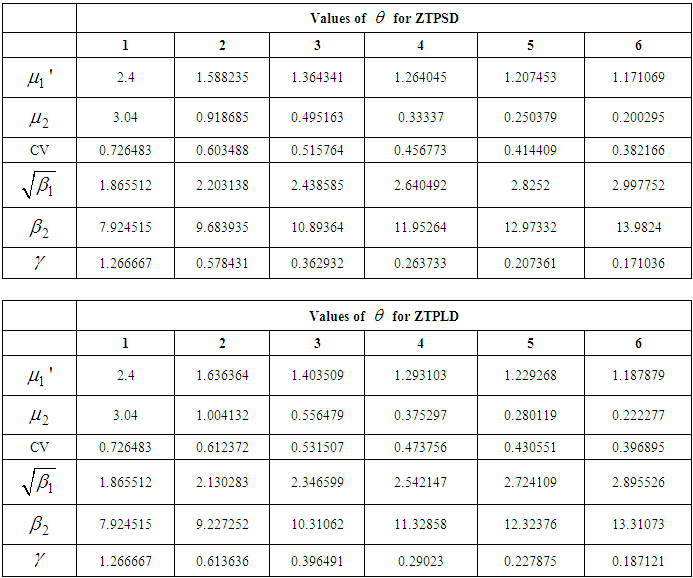 |
| |
|
4. Estimation of Parameter
4.1. Maximum Likelihood Estimate (MLE) of Parameter: Let  be a random sample of size
be a random sample of size  from the ZTPSD (2.3) and let
from the ZTPSD (2.3) and let  be the observed frequency in the sample corresponding to
be the observed frequency in the sample corresponding to  such that
such that  where
where  is the largest observed value having non-zero frequency. The likelihood function
is the largest observed value having non-zero frequency. The likelihood function  of the ZTPSD (2.3) is given by
of the ZTPSD (2.3) is given by The log likelihood function is given by
The log likelihood function is given by and the log likelihood equation is thus obtained as
and the log likelihood equation is thus obtained as The maximum likelihood estimate
The maximum likelihood estimate  of
of  is the solution of the equation
is the solution of the equation  and is given by the solution of the following non-linear equation
and is given by the solution of the following non-linear equation where
where  is the sample mean. This non-linear equation can be solved by any numerical iteration methods such as Newton- Raphson method, Bisection method, Regula –Falsi method etc. In the following theorem, the consistency and asymptotic normality of maximum likelihood estimator of ZTPSD has been established.Theorem: The ML estimator
is the sample mean. This non-linear equation can be solved by any numerical iteration methods such as Newton- Raphson method, Bisection method, Regula –Falsi method etc. In the following theorem, the consistency and asymptotic normality of maximum likelihood estimator of ZTPSD has been established.Theorem: The ML estimator  of
of  of the ZTPSD is consistent and asymptotically normal. That is
of the ZTPSD is consistent and asymptotically normal. That is  where
where  is the Fisher’s information about
is the Fisher’s information about  Proof: The ZTPSD satisfies the regularity conditions under which the ML estimator
Proof: The ZTPSD satisfies the regularity conditions under which the ML estimator  of
of  is consistent and asymptotically normal [see Hogg et al (2005), chapter 6]. We have
is consistent and asymptotically normal [see Hogg et al (2005), chapter 6]. We have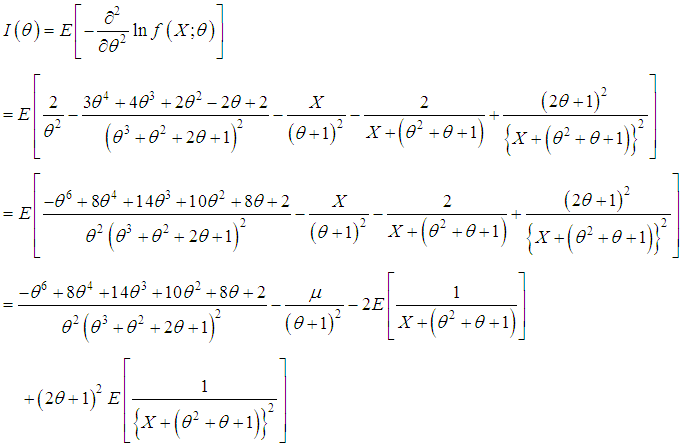 | (4.1.3) |
where  | (4.1.4) |
 | (4.1.5) |
and  | (4.1.6) |
Using equations (4.1.4), (4.1.5), and (4.1.6) in (4.1.3), we get 4.2. Method of Moment Estimate (MOME) of Parameter: Equating the population mean to the corresponding sample mean, MOME
4.2. Method of Moment Estimate (MOME) of Parameter: Equating the population mean to the corresponding sample mean, MOME  of
of  of ZTPSD is the solution of the following non-linear equation
of ZTPSD is the solution of the following non-linear equation where
where  is the sample mean.
is the sample mean.
5. Applications to Real Data Sets
The ZTPSD has been fitted to a number of data - sets to test its goodness of fit over ZTPD and ZTPLD. The maximum likelihood estimate (MLE) has been used to fit the ZTPSD, ZTPLD and ZTPD. Three examples of observed data-sets, for which the ZTPD, ZTPLD and ZTPSD has been fitted, are presented. The first data-set is the number of flower heads as per the number of fly eggs reported by Finney and Varley (1955), the second data- set is the number of yeast cell counts observed per mm square reported by Student (1907) and the third data-set is animal abundance data of Keith and Meslow (1968) regarding the distribution of snowshoe hares captured over 7 days.Table 2. The numbers of counts of flower heads as per the number of fly eggs reported by Finney and Varley (1955)
 |
| |
|
Table 3. Number of yeast cell counts observed per mm square reported by Student (1907)
 |
| |
|
Table 4. Number of Snowshoe hares counts captured over 7 days reported by Keith and Meslow (1968)
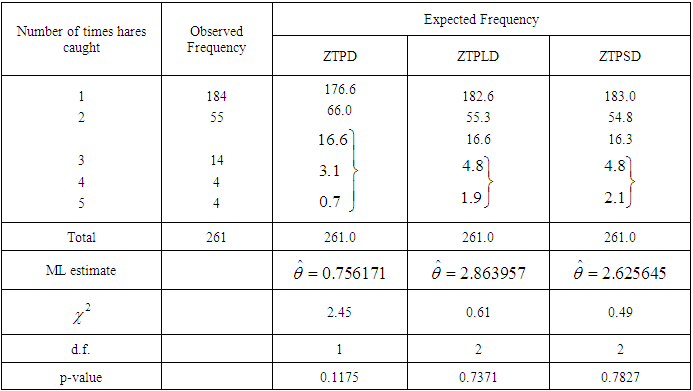 |
| |
|
6. Conclusions
A zero-truncated Poisson-Shanker distribution (ZTPSD) has been introduced. The first four moments about origin and the moments about mean have been obtained. The expressions for coefficient of variation, skewness, kurtosis and index of dispersion of ZTPSD have been given. The method of maximum likelihood and the method of moments have also been discussed for estimating its parameter. Three examples of observed real data- sets have been given to test its goodness of fit over ZTPD and ZTPLD. The goodness of fit of ZTPSD gives quite satisfactory fit over both ZTPD and ZTPLD and thus ZTPSD can be considered an important distribution for modeling zero-truncated count data.
ACKNOWLEDGEMENTS
The author is grateful to the editor in-chief and the anonymous reviewer for their constructive comments which improved the presentation of the paper.
References
| [1] | Barlow, R.E. and Proschan, F. (1981): Statistical Theory of Reliability and Life Testing, Silver Spring, MD. |
| [2] | Finney, D.J. and Varley, G.C. (1955): An example of the truncated Poisson distribution, Biometrics, 11, 387 - 394. |
| [3] | Ghitany, M.E., Atieh, B. and Nadarajah, S. (2008a): Lindley distribution and Its Applications, Mathematics Computation and Simulation, 78, 493 -506. |
| [4] | Ghitany, M.E., Al-Mutairi, D.K. and Nadarajah, S. (2008b): Zero-truncated Poisson-Lindley distribution and its Applications, Mathematics and Computers in Simulation, 79 (3), 279 – 287. |
| [5] | Ghitany, M. E. and Al-Mutairi, D.K. (2009): Estimation Methods for the discrete Poisson-Lindley distribution, Journal of Statistical Computation and Simulation, 79 (1), 1 – 9. |
| [6] | Hogg, R.V., Mckean, J.W. and Craig, A.T. (2005): Introduction to Mathematical Statistics, 6th edition, Pearson Prentice hall, New Jersey. |
| [7] | Keith, L.B. and Meslow, E.C. (1968): Trap response by snowshoe hares, Journal of Wildlife management, 32, 795 - 801. |
| [8] | Lindley, D.V. (1958): Fiducial distributions and Bayes’ theorem, Journal of the Royal Statistical Society, Series B, 20, 102- 107. |
| [9] | Sankaran, M (1970): The discrete Poisson-Lindley distribution, Biometrics, 26, 145 – 149. |
| [10] | Shanker, R. (2015): Shanker distribution and Its Applications, International Journal of Statistics and Applications, 5(6), 338 – 348. |
| [11] | Shanker, R. (2016): The discrete Poisson-Shanker distribution, Jacobs Journal of Biostatistics, 1(1), 1 – 7. |
| [12] | Shanker, R. and Hagos, F. (2015): On Poisson-Lindley distribution and Its Applications to Biological Sciences, Biometrics & Biostatistics International Journal, 2(4), 1– 5. |
| [13] | Shanker, R., Hagos, F. and Sujatha, S. (2015): On modeling of Lifetimes data using exponential and Lindley distributions, Biometrics & Biostatistics International Journal, 2(5), 1-9. |
| [14] | Shanker, R., Hagos, F. and Sujatha, S. (2015): On zero-truncation of Poisson and Poisson-Lindley distribution and Their Applications, Biometrics & Biostatistics International Journal, 2(6), 1- 14. |
| [15] | Student (1907): On the error of counting with a haemacytometer, Biometrika, 5, 351 – 360. |



 is the original distribution. Then the zero-truncated version of
is the original distribution. Then the zero-truncated version of  is defined as
is defined as 





 follows Shanker distribution introduced by Shanker (2015) with pdf
follows Shanker distribution introduced by Shanker (2015) with pdf


 follows a distribution having p.d.f.
follows a distribution having p.d.f.

 and presented in figure 1.
and presented in figure 1.



 is a decreasing function of
is a decreasing function of  is log-concave. Therefore, ZTPSD is unimodal, has increasing failure rate (IFR), and hence increasing failure rate average (IFRA). It is new better than used (NBU), new better than used in expectation (NBUE), and has decreasing mean residual life (DMRL). Detailed discussions about the definitions of these aging concepts are available in Barlow and Proschan (1981).
is log-concave. Therefore, ZTPSD is unimodal, has increasing failure rate (IFR), and hence increasing failure rate average (IFRA). It is new better than used (NBU), new better than used in expectation (NBUE), and has decreasing mean residual life (DMRL). Detailed discussions about the definitions of these aging concepts are available in Barlow and Proschan (1981). where
where 
 Taking
Taking  in place of
in place of  we get
we get
 Using the relationship between moments about origin and moments about mean, the moments about mean of ZTPSD are thus obtained as
Using the relationship between moments about origin and moments about mean, the moments about mean of ZTPSD are thus obtained as The coefficient of variation (C.V), coefficient of Skewness
The coefficient of variation (C.V), coefficient of Skewness  coefficient of Kurtosis
coefficient of Kurtosis  and index of dispersion
and index of dispersion  of ZTPSD are thus obtained as
of ZTPSD are thus obtained as It can be easily verified that the ZTPSD is over dispersed
It can be easily verified that the ZTPSD is over dispersed  equi-dispersed
equi-dispersed  and under dispersed
and under dispersed for
for  respectively. Note that the ZTPLD is over dispersed
respectively. Note that the ZTPLD is over dispersed  , equi-dispersed
, equi-dispersed  and under dispersed
and under dispersed  for
for  respectively.The nature of coefficient of variation, coefficient of skewness, coefficient of kurtosis, and index of dispersion of ZTPSD for varying values of the parameter θ are shown in figure 3.
respectively.The nature of coefficient of variation, coefficient of skewness, coefficient of kurtosis, and index of dispersion of ZTPSD for varying values of the parameter θ are shown in figure 3.
 be a random sample of size
be a random sample of size  from the ZTPSD (2.3) and let
from the ZTPSD (2.3) and let  be the observed frequency in the sample corresponding to
be the observed frequency in the sample corresponding to  such that
such that  where
where  is the largest observed value having non-zero frequency. The likelihood function
is the largest observed value having non-zero frequency. The likelihood function  of the ZTPSD (2.3) is given by
of the ZTPSD (2.3) is given by The log likelihood function is given by
The log likelihood function is given by and the log likelihood equation is thus obtained as
and the log likelihood equation is thus obtained as The maximum likelihood estimate
The maximum likelihood estimate  of
of  is the solution of the equation
is the solution of the equation  and is given by the solution of the following non-linear equation
and is given by the solution of the following non-linear equation where
where  is the sample mean. This non-linear equation can be solved by any numerical iteration methods such as Newton- Raphson method, Bisection method, Regula –Falsi method etc. In the following theorem, the consistency and asymptotic normality of maximum likelihood estimator of ZTPSD has been established.Theorem: The ML estimator
is the sample mean. This non-linear equation can be solved by any numerical iteration methods such as Newton- Raphson method, Bisection method, Regula –Falsi method etc. In the following theorem, the consistency and asymptotic normality of maximum likelihood estimator of ZTPSD has been established.Theorem: The ML estimator  of
of  of the ZTPSD is consistent and asymptotically normal. That is
of the ZTPSD is consistent and asymptotically normal. That is  where
where  is the Fisher’s information about
is the Fisher’s information about  Proof: The ZTPSD satisfies the regularity conditions under which the ML estimator
Proof: The ZTPSD satisfies the regularity conditions under which the ML estimator  of
of  is consistent and asymptotically normal [see Hogg et al (2005), chapter 6]. We have
is consistent and asymptotically normal [see Hogg et al (2005), chapter 6]. We have



 4.2. Method of Moment Estimate (MOME) of Parameter: Equating the population mean to the corresponding sample mean, MOME
4.2. Method of Moment Estimate (MOME) of Parameter: Equating the population mean to the corresponding sample mean, MOME  of
of  of ZTPSD is the solution of the following non-linear equation
of ZTPSD is the solution of the following non-linear equation where
where  is the sample mean.
is the sample mean. Abstract
Abstract Reference
Reference Full-Text PDF
Full-Text PDF Full-text HTML
Full-text HTML and
and  of ZTPSD and ZTPLD
of ZTPSD and ZTPLD


